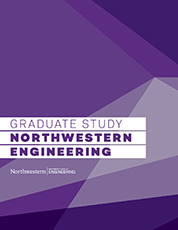Bringing Sustainability into Human-Centered Design
EDI students begin the program by getting hands-on experience with real product innovation projects sponsored by Procter & Gamble.
Human-centered design is a hallmark of Northwestern's Master of Science in Engineering Design Innovation (EDI) program, and the process is introduced to students during their first quarter in the program.
The Human-Centered Design studio course walks students through the concepts of user observation, visualization, rapid prototyping, and iteration by exposing students to real product innovation projects sponsored by Procter & Gamble (P&G).
 The most recent course saw students work in teams on four different upstream P&G projects involving diapering, insect repellants, toothpaste, or skincare. The projects focused on how the product and package design could solve consumer tensions and deliver new P&G technologies to consumers.
The most recent course saw students work in teams on four different upstream P&G projects involving diapering, insect repellants, toothpaste, or skincare. The projects focused on how the product and package design could solve consumer tensions and deliver new P&G technologies to consumers.
Helen von den Steinen, a principal scientist with P&G's research and development team, teaches the course with EDI co-director Jim Wicks.
"The students always surprise and impress us with their new perspectives and ideas," von den Steinen said. "They look at the projects with a different lens than P&G and are not encumbered by what has been done before. Their solutions provide inspiration for the P&G project teams as they move forward with the projects."
von den Steinen is also cofounder of EC30, P&G’s first brand singularly focused on delivering sustainable product solutions.
She makes a point in class to bust the myth that sustainability is only about product packaging or end-of-life waste.
"At P&G, we believe that sustainability must be built in, not bolted on, to the product proposition," she said. "We need to look at the full picture from cradle to grave to understand all the impacts from raw material choices through product design, manufacturing, distribution, and consumer usage."
One of the challenges with developing sustainable products is that sustainability alone will not drive consumer purchases. Products still have to perform their basic function well.
"Consumers will not buy a more sustainable product if it does not work well or provide them with other delightful benefits," von den Steinen said. "We must develop products that both work well and are more sustainable.
"We also need to develop products that support the consumer in forming more sustainable usage habits."
Developing laundry detergents that clean well in cold water is an example of how to support those habits, she said, because the consumer no longer will need to use the energy required to heat water. It's that type of thinking that she encourages students to consider throughout the Human-Centered Design studio course.
It's not always easy, von den Steinen said, but it's worth it.
"Companies like P&G are working hard against sustainability goals, but there is no silver bullet," she said. "I hope EDI students gain an appreciation of the challenges of making more sustainable products. I am sure they will make a big impact in their future careers by taking sustainability considerations into all their design and innovation work."

